
July 2010
John Vincent Bellezza
This month’s Flight of Khyung takes in an enormous slice of time in the Tibetan hinterlands. Examining ancient artifacts, this issue once again brings the glories of Tibet to the forefront, the old meeting the new in dramatic and edifying ways. The last part of the newsletter is devoted to a sacred geographic realm in Upper Tibet, a point in space that draws the divinities into creative union.
Faces of ancient Tibet and Mongolia
The faces of ancient Tibet have been preserved in rock art and artifacts. Human beings are of course greatly affected by their own likenesses. To behold the face in all its different aspects is to invoke the entire gamut of emotions.
Here I would like to call attention to a Tibetan copper-alloy talisman (thog-lcags) in the form of an anthropomorphic visage. Reportedly, it was discovered by a Tibetan herder near the famous sacred site of Zang-zang lha-brag, in Sangsang (bZang-bzang) township, Ngam-ring county, an Upper Tibetan location. While the precise provenance of this copper alloy amulet is unclear, it is of Tibetan origins.
Only 3 cm in height, the prominent attachment loop on top of the talisman clearly shows that it was made to be worn. The face on the object has a strong and imposing appearance. Perhaps representing the likeness of an ancestral figure or personal deity, we can surmise that this face was worn for protection, to distinguish social affiliation or to attract any manner of good forces thought to reside in the universe. A renowned auspicious power or capability for good fortune is the yang (g.yang), which is first noted in Old Tibetan documents of Dunhuang. The talismanic visage is somewhat elongated in form and has a rather narrow chin, wide eye sockets, and a long and prominent bridge of the nose. The face with its anatomical features embodies an esthetic at variance with Buddhist iconographic traditions. The dating of such talismans in the absence of firm archaeological data remains conjectural. Stylistic indications strongly suggest a prehistoric attribution; perhaps it can be more accurately assigned to the first half of the first millennium CE.
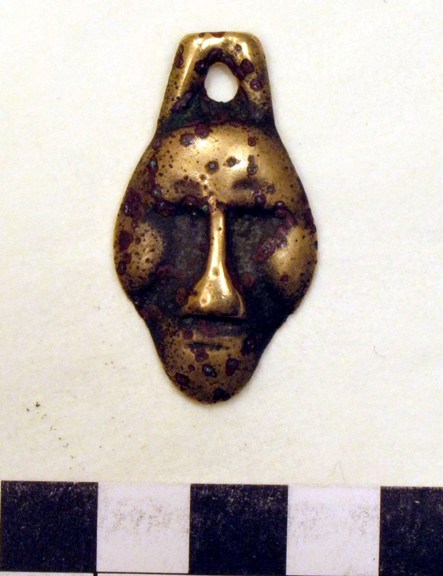
Ancient amulet in the form of a human face, reportedly discovered in Upper Tibet
Now let us move 2500 km to the northeast, to Ushkin Uver in northern Mongolia. This famous funerary stelae complex boasts spectacular deer stones that often feature in general works on the archaeology of Mongolia. Recent archaeological work indicates that these pillars were raised by pre-Scythic tribes, circa 1200–800 BCE. The most unique pillar of Ushkin Uver has an anthropomorphic visage carved on the highest part of the 3 m-tall stone. This face possibly represents the image of an individual interred in the vicinity or it may be that of a funerary protective deity associated with the burial grounds. Like the Tibetan talisman, this stone face is characterized by wide eye orbits, a long and straight bridge of the nose and a narrow chin (large hoop earrings hang from the ears on the sides of the pillar as well).
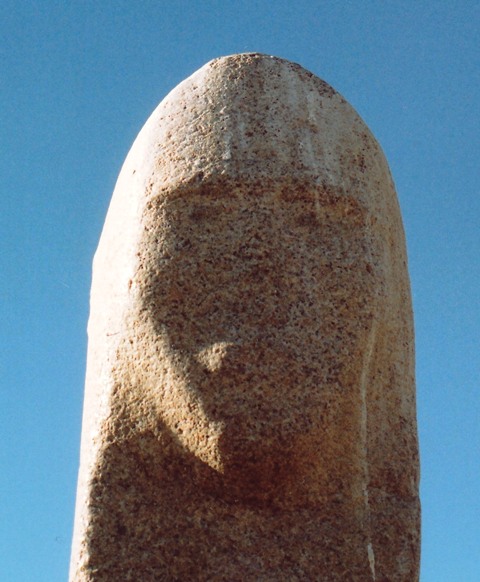
Face of deer stone, Uskin Uver, Mongolia
The facial idiosyncrasies shared by the Tibetan talisman and Mongolian deer stone are vague esthetic indications, which in themselves do not necessarily imply underlying cultural affinities. Nevertheless, as my research and exploration have uncovered a wide range of cultural and archaeological parallels between Tibet and Mongolia in ancient times, there is room to consider the possibility that the two visages may reflect cultural links. In any case, a study of the form is in itself instructive of anthropomorphic renditions in adjoining territories of Inner Asia, separated in time by perhaps a millennium or more.
A bronze dagger discovered in western Tibet
In the late 1990s the Chinese archaeologist Hou Wei and the American Mark Aldenderfer excavated a cemetery in Guge known as Gyaling (rGya-gling). The tombs of Gyaling have been dated to the second half of the first millennium BCE. Among the most impressive artefacts discovered was a bronze dagger in tomb M6, a large earthen burial chamber connected to the surface by a short passageway. In addition to the dagger, pottery, birch bark, stone arrowheads, and sheep head fragments were recovered from two niches cut into the chamber walls of M6. The bronze knife as well as human bones were placed upon the red ochre strewn floor of this chamber. Indications from the archaic funerary traditions of Tibet suggest that this dagger may have been deposited in the tomb as a harm-repelling ritual instrument.
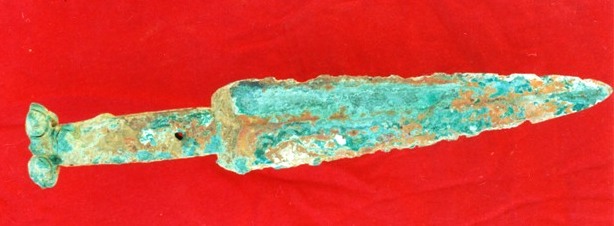
Dagger discovered in rGya-gling tomb M6. Photo courtesy of Shargen Wangdu
The dagger is 30 cm length and was manufactured to standards that compare favorably with contemporaneous bronze daggers of the Chinese and Scythians. This ostensibly Tibetan manufactured variant features finely embossed beadwork and ribbing on the handle. This ornamentation is indicative of a high level of proficiency in casting methods. We might speculate that this dagger was produced in western Tibet but as so few excavations have been carried out in Tibet it is difficult to know one way or the other. The existence of this object in the badlands of Guge certainly indicates that the local inhabitants were well acquainted with the state-of-the-art manufacturing techniques of the time. This knowledge manifested itself either in an object of indigenous production or one of foreign make that is reflective of extensive trade connections. In either case, Guge of the first millennium BCE was a region with vibrant avenues to outlying regions. This active participation in the cultural and technological life of the times is mirrored in the monumental assemblage of the region. These monuments included a wide range of residential and ceremonial structures, the hallmark of a region with sophisticated civilizational tendencies.
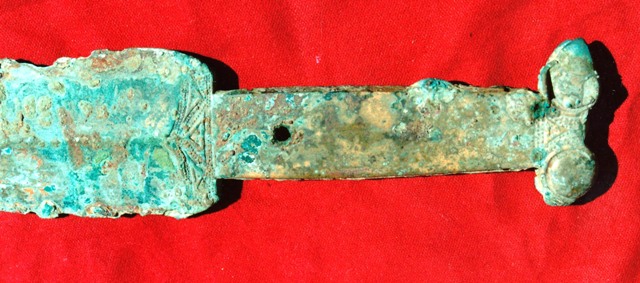
Close-up of dagger handle, rGya-gling, M6. Photo courtesy of Shargen Wangdu
Readers will be able to soon explore the monuments of Guge in far greater detail as two large volumes on the pre-Buddhist archaeology of Upper Tibet are soon to appear on the thlib.org family of websites. For me this work has been the main focus of the last two and a half years.
Gold objects surface in Central Tibet
Refined metallic objects dating to Tibet’s pre-Buddhist past have been discovered in many other areas of Tibet as well. In April 2000, rudimentary excavations were carried out at Meiduo (Tibetan spelling?), a village near the southeastern tip of Yardrok Yumtsho (Yar-’brog g.yu-mtsho), by the Shannan Prefectural Bureau of Cultural Relics. I am only familiar with a single three-page report describing the extremely important artifacts discovered at this site. The tomb(s) from which they were discovered is reported to have been flood-damaged. Various objects were evidently carried off by local residents before its existence came to the attention of local authorities. In the published paper, the Meiduo site is pronounced to be around 2000 years old but no reasons are given for this chronological attribution. This lack of attention to crucial considerations, let alone to fine detail, appears to have characterized archaeological work in Meiduo.
Seventeen gold artefacts, including five plaques of ungulates (around 4.5 cm x 2.3 cm, and 1 mm thick), eight finger rings with a spiral design, two buckles with intact pins, and a pair of earrings were recovered. The other two gold objects found at Meiduo include what may possibly be a stylized bow and arrow pendant (10.5 cm in diameter) and a gold tube with a beaded design (7.3 cm in length) that may have been used as a hair ornament. Also, two cowrie shells, 16 cylindrical beads of semi-precious stones, two three-pointed copper objects, two copper accessories for use on a belt (?), and a fragment of a ceramic vessel were found. The current whereabouts of these artifacts are not known to me.
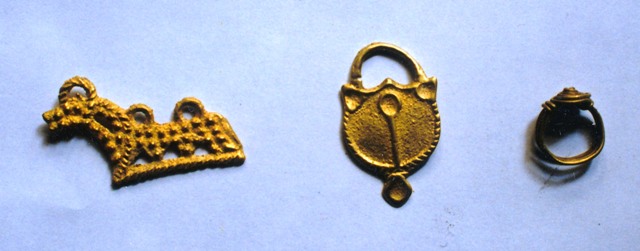
Gold objects unearthed at Yar-‘brog g.yu-mtsho. Photo courtesy of Shargen Wangdu
In the image presented here, one of the animal plaques appears on the left. It seems to depict a caprid, as demonstrated by the helical horn depicted on its head. This plaque was cast with two accessory loops so that it could be worn as a piece of jewelry or amulet. The entire body, legs and head of the animal are covered in beading. What may be a stylized bow and arrow appears in the middle of the image. This object was beautifully conceived and executed. Its graceful lines convey considerable potency. On the right is one of the gold rings with a spiral design. Like the other two objects in the photograph, this ring was expertly cast; unquestionably part of a well established and refined gold working tradition. The three depicted objects are directly comparable to copper-alloy talismans of the thog-lcags class, for which they are liable to be functionally related (if so, they were replete with protective and symbolic value). These items are of Tibetan manufacture and were made no later than the imperial period; however, a much earlier date for their creation might also be entertained. Without firm chronometric indications we cannot be certain.
How many such finds in precious metals have been made in Tibet over the last half century may never be determined. Many such artefacts end up in the international art and antiquities market before they can be properly catalogued and studied. Trade is brisk and countless archaeological sites on the Tibetan Plateau have been exploited and destroyed in recent decades. Unfortunately, this trade shows no signs of abating, its volume determined by market availability more than anything else.
The main gateway of Mount Nyenchen Thanglha
On the north shore of holy Lake Nam Tsho is a spectacular topographical feature known as Thanglhai Gyago (Thang-lha’i rgya-sgo), a natural archway set on a rocky prominence that juts into the lake. This formation is said to have the likeness of an elephant, to which it has an uncanny resemblance. Thang-lha’i rgya-sgo is situated near the ruins of Chado (Bya-do), a monastery that was never rebuilt after the destruction of 50 years ago. The elephantine limestone formation is punctuated by a natural opening 6 m in height. This is the so-called the ‘main gateway of Mount Thang-lha’, a location that is reputed to have enormous geomantic power. As one steps through the natural doorway, Mount Thangla is directly in line on the opposite side of the lake. It is at this point that the sacred lake and mountain are said to be conjoined in a union of cosmogonic significance. This mystic site must have been the object of wonder from ancient times, as suggested by its geographic aspect and grandeur.
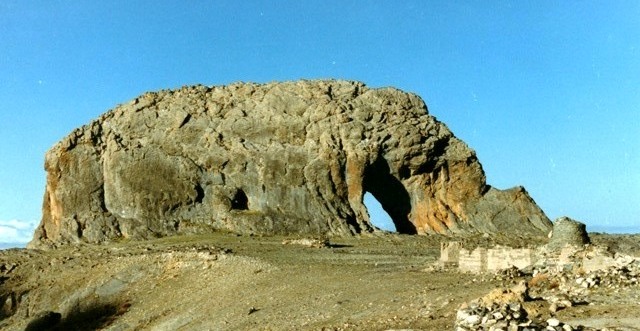
Thang-lha’i rgyal-sgo, gNam-mtsho
In recent centuries Thang-lha’i rgyal-sgo is where pilgrims circumambulating Nam Tsho would petition the divine mountain and lake, the archetypal mother and father in the folk traditions of the region. These devotional exercises may well have had ancient precedents, traced to a time when Bya-do (Bird headland) appears to have been called Bya-Dur (Bird Tombs). In the oral tradition of Nam Tsho, Bya-do is said to have once been a bon holy site. I only learned of its bon aura after the publication of my first book Divine Dyads (1997). Minor ruins on the opposite side of the cove from Thang-lha’i rgya-sgo are thought to be remains from the earlier era.
Bya Do with its many cave shelters would have been prime real estate for the ancient inhabitants of the region. Its supposed old name, Bird Tombs, certainly suggests a crucial cultural role for the site. In the archaic funerary traditions of Tibet, birds and territorial deities played an important role in the soteriological process. Perhaps Bya Do was once such a center of endeavor and aspiration?